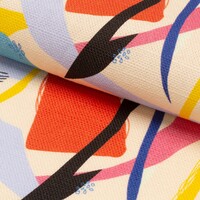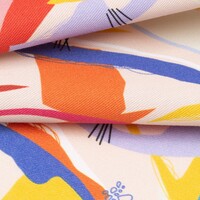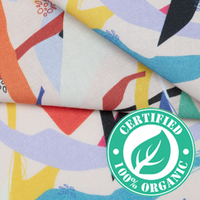Related:
Back to Site Stores ({{popupVm.storeTotalCount}})
Artists ({{popupVm.artistTotalCount}})
Create your own beautiful patchwork piece with our selection of patchwork fabric, printed with your own ph... Read More
Ships in 3 - 4 days
Delivery $15.50
Handmade
Design patchwork upholstery fabric with your photos, images and text for your next patchwork project. Browse a selection of non-stretch patchwork fabrics.
Browse our range of patchwork fabrics
Medium weight, silky and non-stretch with a shiny finish, smooth and opaque, perfect for quilting
100% polyester
Medium weight, soft and non-stretch with a matte finish, smooth and opaque and great for quilting
84% cotton / 16% poly
Medium weight, soft and non-stretch, matte and opaque, great for quilting
95% cotton 5% linen
Medium weight, soft and non-stretch with a matte finish, opaque and ideal for quilting
100% cotton
Medium weight, soft and non-stretch, coarse with a matte finish, semi transparent and great for quilting
100% cotton
Care instructions
Wash at 30°c, low tumble dry heat, hang to dry, do not wring, low heat iron.




Patchwork is a pieced work, which is done by sewing different pieces of fabric together into a bigger design. The larger design can be a very simple pattern, using squares of an equal size and shape, in a repetitive pattern, however this is not always the case. Some patchwork pieces are made up of different sized and shaped pieces of fabric; geometric shapes are easier to piece together, but you have full creative freedoms to create whatever sized or shaped pieces you like. Historically patchwork pieces used up all the scraps of other fabrics, and can be dated back as far as 5000 years ago, being found in Egyptian tombs and early age China. During the Great Depression, patchwork had a widespread revival, to recycle worn clothing into warm quilts. Patchwork quilts tend to use the patchwork piece as the top layer, with a layer of wadding and and a bottom backing layer. Patchwork pieces can be used to create cushions, bags, wall hangings, patchwork upholstery fabric and even jackets.
We print your patchwork material by the yard or metre, in bespoke sizes chosen by you. The patchwork fabric is then digitally printed with your design using one of our expert printing methods. Natural fabrics tend to use pigment printing techniques, applying coloured dyes directly to the fabric in a localised area to build up your custom design. Synthetic fabrics favour our dye sublimation process, printing your personalised design onto a transfer paper, and then with heat, bonding this to the fabric. In regards to Cotton Linen please note that occasional small white dots may occur. This is where pieces of cotton fluff have been removed revealing unprinted white base material. This is both normal and unavoidable, but won't compromise your detailed design.
You can choose to have your patchwork upholstery fabric hemmed, with either an overlock or baby hem, in either black or white thread. As your patchwork material will likely be stitched together with other patchwork fabrics, you might prefer to have it either cut on the line with all white edges removed, or sent as it comes directly from the printer, with your print, and an untrimmed edging.
We print at 200dpi, which is a good combination of quality and file weight. Ideally, your image should be scaled to 100% at 200dpi; this means that no resizing of your file occurs, preventing any interpolation. Our design interface will have a quality marker next to the design that you have uploaded, this will change colour using a traffic light system and display a message. The message will let you know if the resolution is too low or if you have a good quality image.
When you upload your design our system will automatically scale it to fit your chosen fabric dimensions. In the ‘Product Options’ tab, the displayed dimensions under ‘Print Size’ will show the dimensions of the piece of fabric that you are ordering. For image/design dimensions you need to see the ‘Images & Text Tools’ tab. You can see and edit the dimensions of the image under the quality information next to the thumbnail.
We advise providing images in the RGB colour space. Specifically using the sRGB image profile, to achieve best colour results. What does this mean? In your editing software choose RGB as the working space, and assign the image profile as sRGB (full name sRGB IEC61966-2.1)
For most of our fabrics, there is no limit on the length of the fabric that you can order. We have a preview design window set up to 10m max to visualise the print, but that's not a print limit. If you'd like to order more, increase the quantity (x2 for 20m or x4 for 40m for example) and then you can order as much as you'd like, with a built-in automatic volume discount too. The maximum print width of each fabric can be found on the individual fabric pages or in our design interface.
Yes, that might help you! Always incorporate any extra space or boarders into your purchased fabric size. We trim squarely around fabric samples and fabric prints, leaving approximately 5mm white space. Cutting neatly on the line has an additional fee.
Crocking, which is fading along the creases, often after washing or heavy use, occurs when you digitally print on natural fabrics - more so when dark or dense colours are used. It can be minimised by using a cool hand wash instead of machine washing as the tumbling of the machine is the main cause of this. To avoid entirely, we would advise using a poly fabric.
Our organic fabrics do not have any coatings that the non-organic fabrics have. This means the ink absorbs into the fibres, reducing the colour strength slightly (by approx. -40%). For super strong colours we recommend a non-organic natural fabric.
Unfortunately not; we like to test meticulously so that we know what gets best results on our fabrics, and our facilities cater perfectly to them. We do however print sublimation paper to order, and if you have access to a heat press you can press your own fabrics easily.
For multi-coloured or very detailed files we recommend using a tiff format, but they must be flattened. For simple colours and low detail files, a jpeg is fine.
Just like many fabric printing processes, there is the potential for shrinkage. Depending on the fabric, please expect and allow between 2-8% shrinkage which you need to plan for in your dimensions. This percentage can vary from print run to print run and between fabrics, so we would advise ordering a little more material than you require for your project.
We do not offer to print on both sides of the fabric. A lot of our fabrics are semi-transparent or have some show through and this wouldn't work with double-sided printing. This is not a service that we offer on any of our fabrics.
At the moment no, our labels are all printed on the same satin fabric. We may introduce more in the future, but for now, this is the best choice. The labels are all cut the same way. You can order the fabric of your choice and make the labels yourself, but we do not cut different fabric into label format.
With environmental consciousness in mind, our fabrics are all printed using completely water-based inks. This means no chemicals or solvents are used. Our heat fixing procedure fixes the colours and prints, avoiding the downsides of steaming, such as excess or contaminated water returning into the waste system. We have one facility in London where we conduct all the printing, production and fulfilment. Rather than roll the fabrics, or send them in a tube, we fold them before they are sent out to you. This saves over 150 tubes a week, as well as a lot of space on the delivery van. (For delicate fabrics we ensure to package appropriately).
We work at improving our colour profiles all the time. Though rare it may happen that from one print run to another, and there could be slight colour differences, this is normal and part of the process when we are constantly improving. It is extremely unlikely that there will be a huge difference (like orange instead of red for example). Please bear in mind such colour variations can be intensified from fabric to fabric due to the varying grains and textures of the fabric; natural fabrics tend to have more muted colours than their poly alternatives. This is due to the construction of the materials as well as the print methods that have to be altered slightly for more delicate, natural textiles.
We have a full Cut & Sew service here at Bags of Love, and are able to hem your fabric prints for a small additional charge. We create a small one- or two-fold hem that typically uses 5 to 20mm of material, depending on the thickness of the fabric. So, for example, if you want a finished piece of fabric that measures 100 x 100cm, you will need to order a size of 101.5cm x 101.5cm to allow for the hem (on top of that please also allow for shrinkage of min 2%). The thicker the fabric, the bigger the hem will be. You can choose to have your prints hemmed with either Black or White thread. On our silk and other light woven fabrics, one hemmed edge will be straight (vertically down the roll) and the other will be slightly rippled. The hemming material allowances are as follows and you need to make your print bigger to accommodate the hem:
For further information about our fabrics see our FAQs.
Please note: As everything we provide is handmade to order, you may find a slight variance in the sizes.









